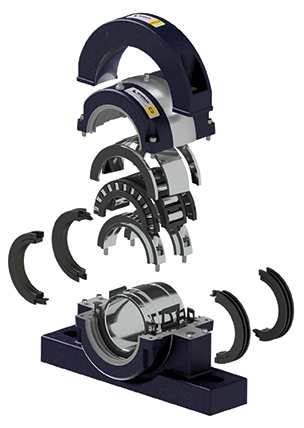
Posted to News on 21st Jun 2021, 00:00
The forgotten criteria in bearing applications
Ian Breeze, Technical Director at Bowman Advanced Split Bearings, explores the increasing importance of load types in industrial applications and how innovation in bearing design can help to avoid system failure, unplanned downtime, and increased maintenance costs.

In industrial plant applications, increased production demands, longer running times and more corrosive environments are putting industrial machinery under pressure. As crucial components in the operational efficiency of any machine, bearings must be able to withstand increasing forces and runtime
In very simple terms, a bearing is a mechanical device that either guides or confines the motion of the moving parts in a machine. In doing so, the bearing reduces friction amongst components, improving the rate of wear and extending the working life of the equipment. Split roller bearings, in particular, are renowned for their ability to improve efficiency – saving time during installation, inspection, and maintenance - particularly in applications where access to the shaft is limited.
Yet, despite being a stalwart of the manufacturing industry, split bearing design has remained relatively unchanged since they were first introduced in the early 1900s. The pressures of modern manufacturing, not least the introduction of more automation and increasingly complex machinery has meant that bearing designs have been forced to evolve and innovate to handle higher loads, in particular the ability to handle both radial and axial loads.
Understanding axial and radial forces
When choosing the right bearing for the job, it is important to understand the load and application requirements. If the wrong bearing is used, it may not carry the required load effectively, leading to damage and potential failure. There are two main types of load. Radial load refers to the loads acting at right angles to the shaft, and axial loads are applied parallel to the shaft in both directions. While many bearings are designed to handle either axial or radial loads, high-load applications in heavy side industrial applications often require a combination of the two – a requirement that, due to limitations in manufacturing, has been left largely unmet.
To best serve the needs of high-load applications that have both types of forces in play, many bearing manufacturers and OEMs will use a combination approach, using a pair of bearings to accommodate the load in each direction. The shortcomings of this method mean more space requirements within the machinery – increasing its overall footprint on the factory floor – as well as potential complications with both assembly and access for ongoing maintenance.
While there is an increasing number of bearings on the market that are designed to handle both radial and axial loads, they work by inclining the radial elements to give some axial capacity. In doing so, they trade off radial capacity for axial – a solution that limits the axial load capacity, limiting application usage or putting the bearings at risk of failure.
Both radial and axial load specifications directly relate to the strength and rigidity of the bearings, shaft, and overall machinery. Exceeding these specifications in an application with a high axial load may result in damage to the bearing and have a different impact on efficiency. In fact, studies suggest that exceeding either radial or axial load specifications by 10% may reduce the lifespan of the components by about 1,000 hours – as well as running the very real risk of unplanned downtime. For applications with a high axial load, these solutions are far from ideal.
Innovations in bearing design
Recent innovations in the manufacture of split roller bearings, and the use of additive manufacturing to create more complex component geometries, are allowing the bearing manufacturers to accommodate axial or multidirectional loads as a primary consideration, extending system life and reducing downtime.
With no need to invest in expensive tooling, or set up traditional manufacturing production lines, it is possible to experiment with design features in a way that simply wasn’t possible previously. For Bowman, the technology has facilitated the creation of a bearing that offers a substantial increase in axial and radial load capacity, as well as increased durability, functionality and turnaround time.
In a standard split bearing design, the rollers run against the outer race lips and clamp rings on the inner race assembly of the bearing, creating stress, friction, and a lower tolerance for axial loads. Using engineering-grade 3D-printed Nylon-11 and the latest printing technology, the company has been able to create a bearing design that removes the axial locating lips from the bearing outer race. This means that the radial roller length, as well as the actual number of rollers, can be increased – giving an both a higher load capacity and an approximate increase of x5 radial L10 life.
1000% increase in axial capacity
By adding axial roller and cage assemblies to their design, Bowman has overcome the issue of reductions in axial load by using three sets of rolling elements to allow independent handling of the radial and bidirectional axial loads. The design incorporates the usual benefits of a split bearing system – including bearing changes of up to ten times faster than solid bearings – while increasing the radial capacity by between 25% and 75% and the axial capacity by 1000% compared to standard solutions.
In the UK, downtime costs manufacturers £180bn per year – arguably the biggest contributor to production and profitability losses. With bearings critical to the efficiency and operability of industrial machinery, investing in the right component for the job is a simple yet effective way of minimising the likelihood of unexpected downtime. For this reason, due consideration should be given to ensuring that bearings meet load type and capacity requirements, while also taking into account all important lifecycle costs and ease of installation and maintenance.
Bowman International Ltd (incorporating Oilite Bearings)
10 Isis Court, Wyndyke Furlong
Abingdon Business Park
OX14 1DZ
UNITED KINGDOM
+44 (0)1235 462500








